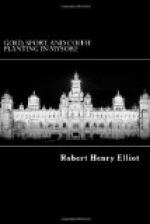I too have had great experience of Borer, and agree with what my friends have written on the subject, with the exception of what Mr. Graham Anderson has said as to the advisability of promptly removing and burning all bored trees. This I am aware is the common practice, but I have never carried it out on my property, and yet, though the trees were riddled with Borer in the great Borer years, and I have had since then a fair proportion of it on some part of my property, I believe that no estate has less Borer now. Instead of removing the bored trees I removed the Borer itself with the aid of the shade of good caste trees, and especially, I believe, by paying strict attention to what I have particularly enforced in my shade section—the prompt filling up of every spot in the plantation that called for more shade. For it is in such spots that the Borer first locates itself, and then it spreads to other dried up trees in the plantation. There is little use, I think, in removing the affected trees. You must remove the cause of their being affected, because, if you do not, the sound trees that are insufficiently shaded will in time be affected: and then it must be remembered that the Borer is a winged insect which, as long as you leave suitable ground for it, will be sure to make its appearance. Out of curiosity I lately cut down and carefully examined a coffee tree which I could see, from the appearance of the bark, had once been heavily bored, but which I felt certain had no Borer now, nor any recent attack of it. The tree I found, after a careful dissection, had not a sign of Borer present in it, nor any sign of a recent attack, and yet in years gone by it had been heavily attacked and bored literally from end to end of the stem. The explanation was that the land had formerly not been sufficiently shaded, while now the shade is ample. The Borers had then left the trees, and their descendants had either not thought it worth while to lay any eggs on them, or the eggs had, from the lowered temperature caused by the shade, become addled. Many years ago I remember cutting down a fine coffee tree, when the round gimlet-made looking hole through which the insect makes its escape was plainly to be seen, when I found that a single Borer had drilled a hole down a part of the centre of the tree, then passed into the fly state and left the tree. It was a fine succulent and nourishing tree, and would, in all probability, have not again been attacked. To remove, then, all attacked trees, as some planters do, seems to me to be a great waste. To do so will not prevent other Borers arriving from some quarter or other to continue the deadly work; but shade, if it does not prevent their arrival, either prevents the insect from laying its eggs, from instinctively feeling that the ground is unsuitable for their being hatched, or causes the eggs to become addled. But whatever the cause may be, it is certain that succulent trees in well shaded land will not suffer from Borer, while it is equally certain that coffee trees in a dried up state, and with either insufficient shade, or shade of bad caste trees over them, are certain to be attacked by Borer again and again, and will eventually be killed.




